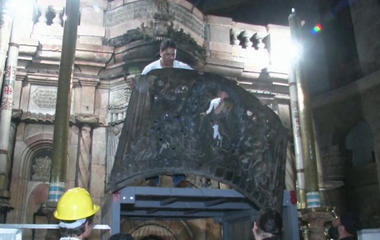Believer or not, it's easy to be moved by the religious history of the splendid city of Jerusalem. Here, Cookie pauses
enroute to the Church of the Holy Seprelcre to see the now complete and laborious restoration of the tomb of Jesus.
ANCIENT SACRED SITE GETS MULTI-MILLION DOLLAR FACELIFT TO USHER IN HOLY DAYS
STORY By CHRISTENE MEYERS
PHOTOS By BRUCE KELLER
and courtesy Associated Press
JUST IN TIME for Passover and Easter, a crack Greek restoration team unveiled an elaborate, high-tech renovation of the Jerusalem shrine housing the tomb where tradition says Jesus was buried and rose.
 |
Restoration complete, the church's famous tomb shines with new luster.
Above left, the church may be approached through a colorful covered bazaar. |
The archaeologists, known for restoration work on historic Egyptian and Turkish sites, were laying the groundwork for the repairs on our last visit. The project has been on the boards since 1959. The shrine needed urgent attention after years of
exposure to moisture, humidity and candle smoke.
We spent two spring days in the city, known for its shrines, mosques and temples and the relics of a trio of major religions: Christianity, Judaism and Islam.
THE TOMB IS known as the Edicule, and rests within the Old City of Jerusalem in the Church of the Holy Seplulchre
 |
Cookie lights a candle near the tomb, honoring her departed.
Above, the tomb shortly before our last visit. |
What struck us was that until recently, the tomb was so dingy and blackened. When next we visit, we are excited to witness the results of the painstaking transformation. The original ivory sheen of the marble has emerged -- the tomb is no longer dark and dingy but looks much as it did centuries ago.
21ST CENTURY techniques -- including radar and thermography -- were used to examine the tomb's supporting structure tomb and ground beneath. The experts, from the National Technical University of Athens, stripped the stone slabs from the shrine’s façade and patched internal masonry, injecting it with grout for reinforcement. Each stone was wiped clean of candle soot and pigeon droppings, then put back in place. Titanium bolts were added for reinforcement, and the shrine's frescos and painted dome were given a facelift.
 |
| Above and below left, painstaking removal of grime restored each stone slab. |
Additional work is necessary to better stabilize the ground. The Greek conservators will be part of that effort, too, after it is approved by those who inhabit and use the church. It is still an active shrine -- and home to 50 monks, who insist that it be kept open for pilgrims. Since the fourth Century AD, the church has been a cemetery. Romans had built a temple there to honor Aphrodite and for centuries it was also a quarry.

NOW GONE IS THE unsightly iron cage built around the shrine by British authorities in 1947 to shore up the walls. Gone are layers of soot from decades of pilgrims' candles. Vastly improved is the stability of the old shrine, which hadn’t been restored in more than 200 years.
“If this repair hadn’t happened now, there could have been a collapse,” Bonnie Burnham of the World Monuments Fund said this week. “This is a complete transformation of the monument.”
A PRIVATE DONATION provided an initial $1.4 million for the $4 million restoration. That gift came from the widow of Atlantic Records founder. Jordan’s King Abdullah II and Palestinian President Mahmoud Abbas each chipped in 150,000 euros -- totaling $320,000. Church donations and other private gifts raised the rest.
The limestone and marble Church of the Holy Sepulcher is among the world’s oldest churches — a 12th-century building on 4th-century remains. Three main Christian denominations jealously guard separate sections of the church, but put aside longstanding religious rivalries to approve the restoration. In 2015, Israeli police briefly shut down the building after Israel’s Antiquities Authority deemed it unsafe. Repairs finally began in earnest in June 2016.
UP NEXT: Julian, California, in the spring is a gorgeous bounty of blooms and fragrance. Come with us to visit this charming mountain town not far from San Diego. From homemade apple pie to art, ice cream to friendly inns and B&Bs, Julian is a quaint, appealing town. Remember to explore, learn and live and catch us Fridays when we post for the weekend.
Right, daffodils are protected in Julian, California, where it is illegal to pick them. The town is famous for apples as well.
|
A pleasure to read this the day after Easter, and following our fifth visit to The Holy Land.
ReplyDeleteWe lived in Jordan for many years and this was a welcome way to revisit this magnificent shrine to three great world religions. Many thanks. So glad the "spruce up" is complete.
ReplyDelete